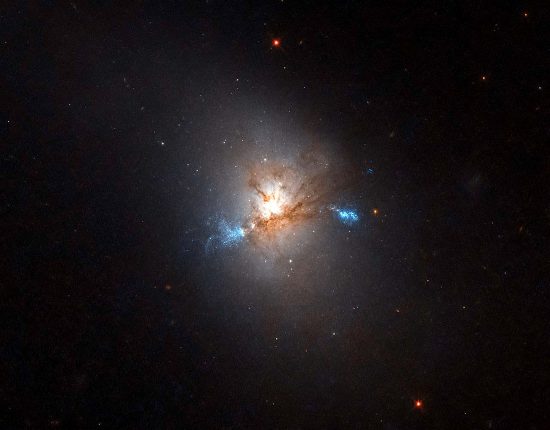Nov 14, 2016
Matter in the plasma state exhibits extreme activity.
According to a recent press release, galaxy NGC 1222 is a “peculiar example” of lenticular galaxy. It is peculiar because lenticular galaxies are supposed to have used up the material available for new stars to form. NGC 1222, on the other hand, is described as a “starburst” galaxy, since new stars are said to be forming at a surprising rate.
Astronomers use high frequency light from their active zones to identify star-forming regions. Extreme ultraviolet and X-rays radiate from “cosmic cocoons”. The best examples are illustrated by one of the most iconic image in modern astrophotography, the “Pillars of Creation” in the Eagle Nebula.
The unusual activity in a galaxy whose fecundity should be long past is because NGC 1222 “…is in the process of swallowing up two much smaller dwarf galaxies…bringing in fresh supplies of gas…”
Consensus opinions suggest that shock waves from “stellar winds” generated by supernovae ram through star-forming regions, causing the wispy dust and gas to compress along the shock front, “jump-starting” star formation. How stellar winds “blow” through space until they encounter dusty gas clouds is not known, however. Another problem associated with star formation is that shock-heated gases should dissipate from increased molecular movement, not collapse.
To say that gas can be heated until it emits X-rays that “blow like a wind” indicates a serious lapse. Molecules of gas cannot remain intact at million degree temperatures because electrons are stripped from the atomic nuclei, causing them to become ionized. Instead of hot gas, the galactic surge should be referred to by its proper name: plasma.
The Electric Star theory resolves many of the distorted opinions that arise from misunderstanding the role of plasma and electric fields in space. Rather than kinetic activity (heated gas), the radiant emanations from NGC 1222 are due to electric charge flow.
Electric discharges in a plasma cloud create double layers, or sheaths, along the current axis. Positive charge builds up on one side and negative charge on the other. An electric field develops between the sides. Electric charge flows along the sheaths. In plasma, the currents “pinch” into filaments. The filaments attract each other, but rather than merging they spiral around, gradually pinching down into arc mode discharges. As the Hubble announcement states: “…we can clearly see dark filaments of dust and bright filaments of gas.”
In an Electric Universe, stars “give birth” electrically from their charged interiors. Stars are not powered by hydrogen fusion but by incoming electric charge. There is no intensely hot core, radiating energy from thousands of kilometers deep inside. Instead, heavy elements are synthesized in the exterior plasma discharges and then “precipitate” into the star’s interior like a rain of metal atoms.
Electric forces acting on a star might offset its internal positive charge. If that happens, the positive charges will repel each other and accelerate away from the center of the star, resulting in an expulsion disk composed of the star’s ionized interior.
When plasma moves through a dust or gas, the cloud becomes ionized and electric charge flows. The currents generate magnetic fields that confine themselves into coherent filaments known as Birkeland currents. The charged particles that compose the currents spiral along the magnetic fields, appearing as electrical vortices. The forces between these spinning Birkeland currents pull them close together and wind them around each other. The three radiant regions in NGC 1222 are examples of z-pinches in those filaments comprising thousands of stars.
Retired Professor of Electrical Engineering, Dr. Donald Scott, author of The Electric Sky, wrote:
“Plasma phenomena are scalable. Their electrical and physical properties remain the same, independent of the size of the plasma. In a laboratory plasma, of course, things happen much more quickly than on, say, galaxy scales, but the phenomena are identical—they obey the same laws of physics. In other words we can make accurate models of cosmic scale plasma behavior in the lab, and generate effects that mimic those observed in space. It has been demonstrated that plasma phenomena can be scaled to fourteen orders of magnitude. (Alfvén hypothesized that they can be scaled to 28 orders or more!) Electric currents flowing in plasmas produce most of the observed astronomical phenomena that remain inexplicable if we assume gravity and magnetism to be the only forces at work.”
Such is the case with all starburst galaxies.
Stephen Smith













